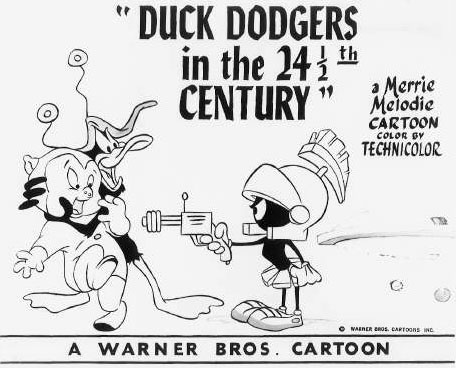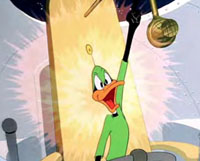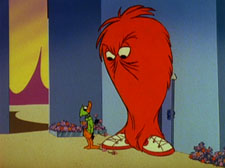
Charles Martin “Chuck” Jones received multiple Academy Award nominations over the years and in 1996 he received an honorary Oscar for “the creation of classic cartoons and cartoon characters whose animated lives have brought joy to our real ones for more than half a century.”
Before this interview, we had met and talked at a variety of animation related events. Unfortunately, my first formal interview with Chuck didn’t take place until Spring 1983 when I was working on a magazine article about the character Duck Dodgers that he had co-created for Warners. Duck Dodgers and the Return of the 24 1/2 Century had been released in 1980 and there was discussion that there might be more Duck Dodgers cartoons.
When he returned a copy of the interview transcript with his corrections, he included a wonderful personalized sketch of Daffy Duck as Duck Dodgers as well as rewriting some of his answers to appear more scholarly.
Here is an excerpt from that interview that I used to help write my article.
 Jim Korkis: How did you come up with the idea for the original Duck Dodgers?
Jim Korkis: How did you come up with the idea for the original Duck Dodgers?
Chuck Jones: That’s always the question, isn’t it? How does anyone come up with any idea? We found that it was always funny having Daffy trying to be the hero. Wouldn’t we all like to actually be the hero like Buck Rogers? Not just dream about being the hero but actually being the hero. In Daffy’s case, the dream becomes a nightmare the more he struggles to be the hero. Then to add Porky to the mix is the key. The Porky character was kind of a square, I suppose, but you always felt, in a cartoon like Duck Dodgers that he had his tongue-in-cheek. There was always some sly awareness there.
JK: The title of the cartoon seems like a natural.
CJ: That’s often where the idea comes originates. We would take a title of something that people knew and then give it a comic twist. “Buck Rogers in the 25th Century” was easy to twist into “Duck Dodgers in the 24 1/2 Century” and made people smile.
JK: So the cartoon was meant to be a parody of Buck Rogers?
CJ: It wasn’t a direct parody. It was making fun of the whole concept of space heroes that were very popular at the time. Except thanks to Maurice Noble we had spectacular sets they could only dream of from the magnificent City of the Future to Planet X.
JK: And searching for Illudium Phosdex, the shaving cream atom?
CJ: All science fiction had this quest for something important, a sense of urgency that we wanted to capture to propel the story. It could have been anything.
JK: How closely did you work with Michael Maltese on the script?
 CJ: There was never a script at Warners. All stories we developed on rough storyboards. Because of the deadlines we had to meet to make sure a cartoon was in the theaters, Mike Maltese had five or six weeks working with me to outline in sketches the cartoon. We also ran it by other directors like Friz (Freleng) and Bob McKimson for ideas as well as getting another perspective on structure.
CJ: There was never a script at Warners. All stories we developed on rough storyboards. Because of the deadlines we had to meet to make sure a cartoon was in the theaters, Mike Maltese had five or six weeks working with me to outline in sketches the cartoon. We also ran it by other directors like Friz (Freleng) and Bob McKimson for ideas as well as getting another perspective on structure.
JK: Again, it seemed natural to bring back Marvin Martian who had already appeared in two previous cartoons since he was already designed.
CJ: I patterned him after the god Mars. That was the uniform that the mythical Roman God of War, Mars, wore with the helmet and the skirt. We thought putting it on this ant-like creature might be funny. But since he had no mouth, we had to convey that he was speaking totally through his movements. We had to use body awareness to define him differently than the other characters. We couldn’t rely just on the dialog.
JK: Did you feel that this cartoon was one of the better ones?
CJ: At the time, we saw it as just another cartoon. It was funny but we had to get started on another cartoon and another. We accomplished what we wanted to do and audiences liked it but they liked just about everything we did. It wasn’t a case of people giving the cartoon a standing ovation in theaters and demanding to see it again.
JK: Film maker George Lucas loved it. He insisted that Duck Dodgers precede his 1977 film “Star Wars” whenever possible.
CJ: Well, Lucas said that he saw “Duck Dodgers” the year it came out, when he was eight years old and he said that it impressed him so much that he decided he wanted to make movies. At least, that’s what he said in interviews at the time. (laughs). Who really knows? Apparently, it had some influence. I know he loved the layouts done by Maurice Noble. Who wouldn’t? They were breathtakingly beautiful.
JK: In fact, I understand that Lucas wanted a sequel made to be shown before the 1980 release of “The Empire Strikes Back”.
CJ: That was a problem because Warners had been closed for years. Friz and I had been doing some television specials using the characters but I had to work hard to reassemble some of my old team. Fortunately, most of the guys I wanted had not spent too much time doing the Saturday morning stuff and dulled their skills. Some of them had worked on commercials that were fully animated. Top people that I needed like Phil Monroe and Ben Washam and others hadn’t lost their touch, fortunately. Of course, we had Maurice Noble again to design a revolutionary spaceship.
 JK: I notice that both you and Michael Maltese receive story credit on this cartoon.
JK: I notice that both you and Michael Maltese receive story credit on this cartoon.
CJ: Yeah, he did some of the story work on this, as always. At Warners, the director was always at least fifty percent of the storyboards. The reason being that whenever you start to lay a picture out, after the storyboard is completed, from that point on the director develops the material. He assigns scenes to different animators and they may come up with some business that the director will decide to use.
JK: But the film was never released theatrically.
CJ: It wasn’t ready in time for the release of “The Empire Strikes Back” but an attempt was made to release it theatrically. It was the centerpiece for the NBC television special Daffy Duck’s Thanks-For-Giving Special in 1980 where Daffy is trying to convince the studio to produce a sequel to “Duck Dodgers”.
JK: How helpful was it to work with the same people all the time?
CJ: The team thing is very important. It gets to the point where you can snap your fingers, or make a single drawing to convey your idea.
JK: Did Warner management realize how important it was to keep together teams that worked well together?
CJ: A classic Eddie Selzer (a top executive at Warners in charge of the animation department) story was when he came in one day and we were just sitting around talking and laughing. He was just fuming in the doorway and said, “What the hell has all this laughter got to do with the making of animated cartoons?” That was one of his classic lines.


 Jim Korkis is an internationally respected animation historian who in recent years has devoted his attention to the many worlds of Disney. He was a columnist for a variety of animation magazines. With his former writing partner, John Cawley, he authored several animation related books including The Encyclopedia of Cartoon Superstars, How to Create Animation, Cartoon Confidential and Get Animated’s Animation Art Buyer’s Guide. He taught animation classes at the Disney Institute in Florida as well as instructing classes on acting and animation history for Disney Feature Animation: Florida.
Jim Korkis is an internationally respected animation historian who in recent years has devoted his attention to the many worlds of Disney. He was a columnist for a variety of animation magazines. With his former writing partner, John Cawley, he authored several animation related books including The Encyclopedia of Cartoon Superstars, How to Create Animation, Cartoon Confidential and Get Animated’s Animation Art Buyer’s Guide. He taught animation classes at the Disney Institute in Florida as well as instructing classes on acting and animation history for Disney Feature Animation: Florida.




















































Too bad YouTube’s being strict about NO CLASSIC CARTOONS being allowed on YouTube.
I just wish Warners didn’t shut down their IN2TV video site shortly around the time Hulu debut. On the other hand, they probably would have eventually made it into a complete pay site.
Nice little interview… speaking for many here, I would have loved to have interviewed Jones as well.
Your last question didn’t get much of an answer, but it suggests that the reason for the successful Looney Tune formula is a team of artists getting to do what they wanted with limited interference (and limited money too unfortunately, but that wasn’t all that important anyway) and getting along well enough with each other personality-wise that they were unafraid to take risks. The fact that DUCK DODGERS was viewed as “just another cartoon” in its day may sound disappointing to us fans today, but just think of the “bombs” that were also viewed as “just another cartoon” and didn’t cost anybody their job. Eventually your team gets so confident and skilled at what they are doing that there are few “bombs”… as was the case with Jones’ unit in the late forties and fifties. At Disney, there was a lot more fussiness and stress, so Ed Selzer’s lack of “oomph” was only troubling on Oscar nights when he would accept awards for “unfunny” cartoons, but otherwise he was just a minor nuisance.
In an oddball way, I sometimes think of the Jones unit like the Arthur Freed unit at MGM handling the best of their feature musicals. OK… yes, these were longer in running time, but fewer in quantity than cartoons. They also hit their stride during this same period, before the studio was forced to economize after GIGI. In other words: MAD AS A MARS HARE = IT HAPPENED AT THE WORLD’S FAIR… the sixties were not quite the same.
In any case, the trade paper reviews were often more important than Oscar recognition anyway. BOXOFFICE viewed this one on August 8th 1953 as “very good”. Their review just gives the plot synopsis but the rating is what counts. http://www.boxoffice.com/the_vault/issue_page?issue_id=1953-8-8&page_no=100#page_start
To be fair, “Mad as a Mars Hare” felt rushed was because it was rushed as this was the last cartoon done by Jones’ unit due to the fact that Jones was fired and the animation studio was close to be shutted downed.
Porky gets the best throwaway line while doing a standard firecracker gag: “Happy Birthday, you thing from another world, you!”
In college I seemed to be the only one who found Daffy’s navigational direction of “due up” funny. Daffy even mugs for a frame, implying Jones & co. expected a big laugh there. On the other hand, the reveal of Porky as the Eager Young Space Cadet brought down the house.
“…As well as rewriting some of his answers to appear more scholarly.” Yet another example of why I find Chuck Jones’ so irritating. Although he outwardly seemed to have a colossal ego, Jones was desperate to be seen as an intellectual whose brain power far outstripped his ability to be funny and entertaining, he must have had a secret lack of confidence as big as the Ritz. How sad that one of the industry’s best-known cartoonists apparently felt that being a successful cartoonist wasn’t enough; he had to be thought of as a “soopah genius”. Feh.